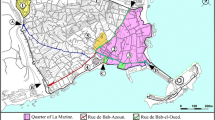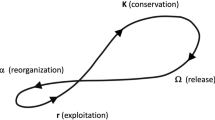Abstract
In responding to the commentaries Ron Johnston reflects on both the origins of “Geography and Geographers” and its relevance to the changing practices within human geography over the last forty years.’
Similar content being viewed by others
Notes
Another feature of that conference session was that Peter and I believe it is the first to be held at an RGS (IBG) meeting at which both of the main presenters were great-grandfathers!
John later told me he was angry at missing the opportunity to publish Urban Residential Patterns (Johnston 1971). I sent him the outline but as an unknown from New Zealand he asked for sample chapters: another publisher offered an immediate contract (on the advice of their editor, R. O. Buchanan, who knew of me through his New Zealand contacts, and his colleague, Michael Wise, who had visited us in New Zealand as I was writing the book).
I even penned my own, unsuccessful (despite the work of the series editor, Bill Morgan), version (Johnston, 1973).
That was based on a final-year option course Freeman gave when I was at Manchester: my wife took it in 1960–1961 but I didn’t in the following year.
As background reading for the Sheffield course I recommended Chorley (1973).
My Sheffield colleague Stan Gregory was a co-founder of what became the Quantitative Methods Study Group but he counselled against its early affiliation with the IBG because of known resistance from ‘senior geographers’ (Johnston 2018).
I recall a colleague at another department telling me a publisher had asked him to write a competitor volume but he responded there was no point, since he couldn’t better mine!
This went unrecognised by some critics (e.g. Mair 1986).
I was once asked why Peter Hall appeared relatively little in the book; my reply was because he did geography, not debate about what geography was/is/should be!
Compare the size of the five editions of The Dictionary of Human Geography, for which I was lead editor on the first four – the first (1981) had 404 pages, the fifth (2009) had 1052: another potential subject for a conference session? Again, apart from some earlier dictionaries that were not aimed at university students, The Dictionary of Human Geography was a pioneer and attracted a large market. It now has a number of competitors.
Katharine Hall also refers favourably to the first chapter’s treatment of the academic career structure. When I submitted the text of the first edition, John Davey’s assistant expressed incredulity that it worked as I described it – and, of course, there is much more casualisation now than then (and worse pensions!).
They still don’t: there is a lot of work based on French philosophers but not much on French geographers (indeed almost all of it is by Hugh Clout!)!
References
Barnes, T. J., & Sheppard, E. S. (Eds.). (2019). Spatial histories of radical geography: North America and beyond. Hoboken, NJ: Wiley.
Chorley, R. J. (Ed.). (1973). Directions in geography. London: Methuen.
Chorley, R. J., & Haggett, P. (Eds.). (1965). Frontiers in geographical teaching. London: Methuen.
Chorley, R. J., & Haggett, P. (Eds.). (1967). Models in geography. London: Methuen.
Craggs, R., & Neate, H. (2019). What happens if we start from Nigeria? Diversifying histories of geography. Annals of the American Association of Geographers. https://doi.org/10.1080/24694452.2019.1631748.
Freeman, T. W. (1963). A hundred years of geography. London: George Duckworth.
Haggett, P. (1965). Locational analysis in human geography. London: Edward Arnold.
Harvey, D. (1973). Social justice and the city. London: Edward Arnold.
James, P. E. (1972). All possible worlds: A history of geographical ideas. Indianapolis: Odyssey Press.
Johnston, R. J. (1971). Urban residential patterns: An introductory review. London: G. Bell and Sons.
Johnston, R. J. (1973). Spatial structures: Introducing the study of spatial systems in human geography. London: Methuen.
Johnston, R. J. (1974). Continually changing human geography revisited: David Harvey: Social justice and the city. New Zealand Geographer, 30, 180–192.
Johnston, R. J. (1975). Regarding bourgeois geography and original sin. New Zealand Geographer, 31, 192–193.
Johnston, R. J. (1978). Paradigms and revolution: observations on human geography since the Second World War. Progress in Human Geography, 2, 189–206.
Johnston, R. J. (2006). The politics of changing human geography’s agenda: textbooks and the representation of increasing diversity. In Transactions of the Institute of British Geographers, NS31, pp. 286–303.
Johnston, R. J. (2018). Stanley Gregory 1926–2016. In E. Baigent & A. Reyes Novaes (Eds.), Geographers: Biobibliographical studies, vol. 37 (pp. 69–104). London: Bloomsbury.
Johnston, R. J. (2019). Percy Crowe: A forgotten pioneer quantitative geographer and climatologist. Progress in Physical Geography, 43, 586–600.
Johnston, R. J. (2020). Encountering Alan Wilson, filling the gaps in data sets (from the knows to the unknowns) … and disciplinary history/progress. Interdisciplinary Science Reviews, in press.
Johnston, R. J., Harris, R., Jones, K., Manley, D., Sabel, C. E., & Wang, W. W. (2014a). Mutual misunderstanding, and avoidance, mis-representations and disciplinary politics: spatial science and quantitative analysis in (UK) geographical curricula. Dialogues in Human Geography, 4, 3–25.
Johnston, R. J., Harris, R., Jones, K., Manley, D., Sabel, C. E., & Wang, W. W. (2014b). One step forward but two steps back to the proper appreciation of spatial science. Dialogues in Human Geography, 4, 59–69.
Jones, F. L. (1969). Dimensions of urban social structure: The social areas of Melbourne, Australia. Canberra: Australian National University Press.
Livingstone, D. N. (1992). The geographical tradition: Episodes in the history of a contested enterprise. Oxford: Blackwell.
Livingstone, D. N., Monk, J., Johnston, R. J. (2007). Classics in human geography revisited. Johnston, R. J. 1979: Geography and geographers: Anglo-American human geography since 1945. Progress in Human Geography, 31, 43–52.
Mair, A. (1986). Thomas Kuhn and understanding geography. Progress in Human Geography, 10, 345–370.
Rowley, G. (1975). Continually changing human geography: A rejoinder. New Zealand Geographer, 31, 189–191.
Taylor, P. J., & Johnston, R. J. (1979). Geography of elections. London: Harmondsworth.
Timms, D. W. G. (1965). Quantitative techniques in urban social geography. In R. J. Chorley & P. Haggett (Eds.), Frontiers in geographical teaching (pp. 239–265). London: Methuen.
Timms, D. W. G. (1971). The urban mosaic: Towards a theory of residential differentiation. Cambridge: Cambridge University Press.
Author information
Authors and Affiliations
Corresponding author
Additional information
Publisher's Note
Springer Nature remains neutral with regard to jurisdictional claims in published maps and institutional affiliations.
Rights and permissions
About this article
Cite this article
Johnston, R. Geography and geographers: re-revisited—again. GeoJournal 87 (Suppl 3), 385–388 (2022). https://doi.org/10.1007/s10708-020-10206-3
Published:
Issue Date:
DOI: https://doi.org/10.1007/s10708-020-10206-3




